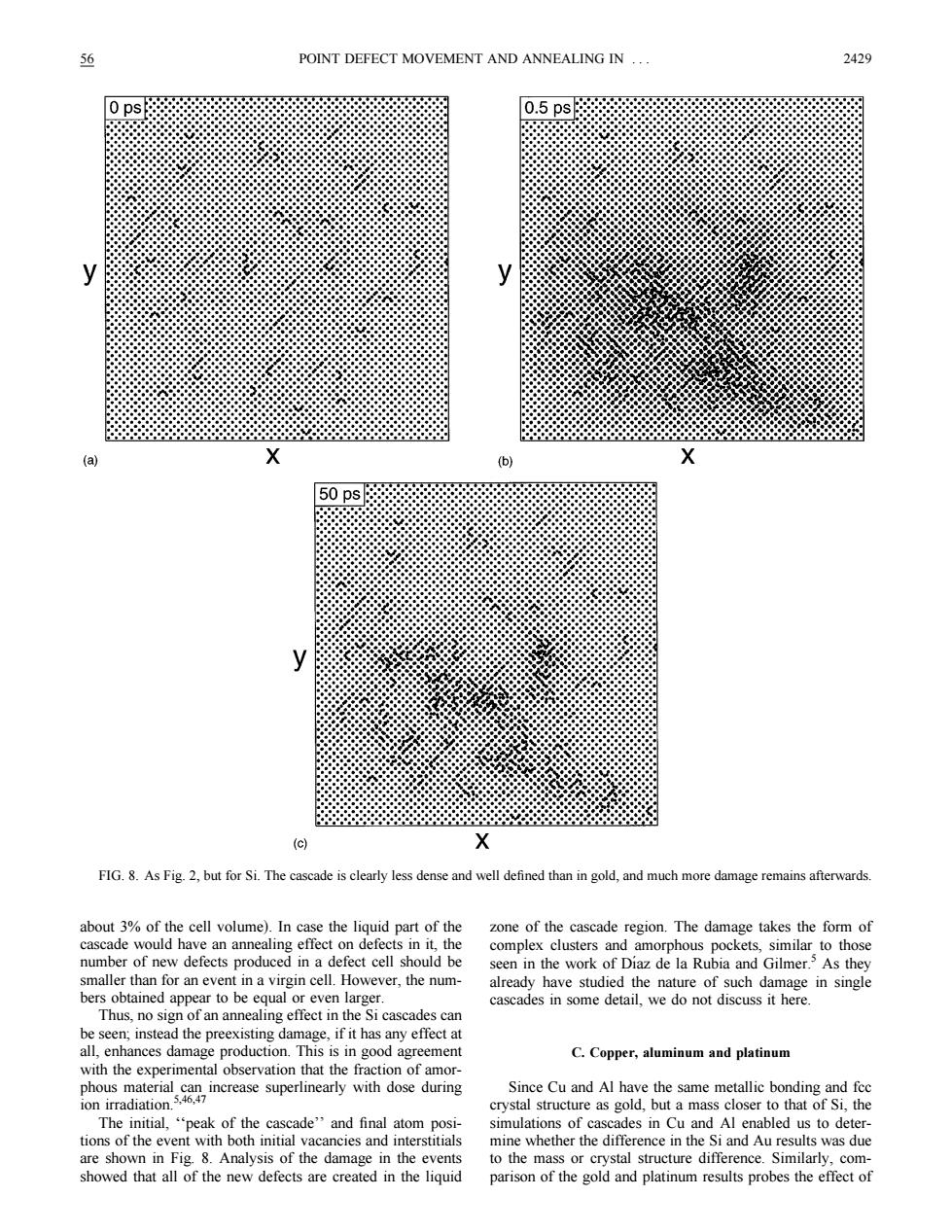正在加载图片...

56 POINT DEFECT MOVEMENT AND ANNEALING IN .. 2429 0.5ps (a) (b) 50 ps (c) FIG.8.As Fig.2,but for Si.The cascade is clearly less dense and well defined than in gold,and much more damage remains afterwards. about 3%of the cell volume).In case the liquid part of the zone of the cascade region.The damage takes the form of cascade would have an annealing effect on defects in it.the complex clusters and amorphous pockets,similar to those number of new defects produced in a defect cell should be seen in the work of Diaz de la Rubia and Gilmer.As they smaller than for an event in a virgin cell.However.the num- already have studied the nature of such damage in single bers obtained appear to be equal or even larger. cascades in some detail.we do not discuss it here. Thus,no sign of an annealing effect in the Si cascades can be seen:instead the preexisting damage,if it has any effect at all,enhances damage production.This is in good agreement C.Copper,aluminum and platinum with the experimental observation that the fraction of amor- phous material can increase superlinearly with dose during Since Cu and Al have the same metallic bonding and fec ion irradiation.5.46,47 crystal structure as gold,but a mass closer to that of Si,the The initial,"peak of the cascade'and final atom posi- simulations of cascades in Cu and Al enabled us to deter- tions of the event with both initial vacancies and interstitials mine whether the difference in the Si and Au results was due are shown in Fig.8.Analysis of the damage in the events to the mass or crystal structure difference.Similarly,com- showed that all of the new defects are created in the liquid parison of the gold and platinum results probes the effect ofabout 3% of the cell volume!. In case the liquid part of the cascade would have an annealing effect on defects in it, the number of new defects produced in a defect cell should be smaller than for an event in a virgin cell. However, the numbers obtained appear to be equal or even larger. Thus, no sign of an annealing effect in the Si cascades can be seen; instead the preexisting damage, if it has any effect at all, enhances damage production. This is in good agreement with the experimental observation that the fraction of amorphous material can increase superlinearly with dose during ion irradiation.5,46,47 The initial, ‘‘peak of the cascade’’ and final atom positions of the event with both initial vacancies and interstitials are shown in Fig. 8. Analysis of the damage in the events showed that all of the new defects are created in the liquid zone of the cascade region. The damage takes the form of complex clusters and amorphous pockets, similar to those seen in the work of Dı´az de la Rubia and Gilmer.5 As they already have studied the nature of such damage in single cascades in some detail, we do not discuss it here. C. Copper, aluminum and platinum Since Cu and Al have the same metallic bonding and fcc crystal structure as gold, but a mass closer to that of Si, the simulations of cascades in Cu and Al enabled us to determine whether the difference in the Si and Au results was due to the mass or crystal structure difference. Similarly, comparison of the gold and platinum results probes the effect of FIG. 8. As Fig. 2, but for Si. The cascade is clearly less dense and well defined than in gold, and much more damage remains afterwards. 56 POINT DEFECT MOVEMENT AND ANNEALING IN . . . 2429